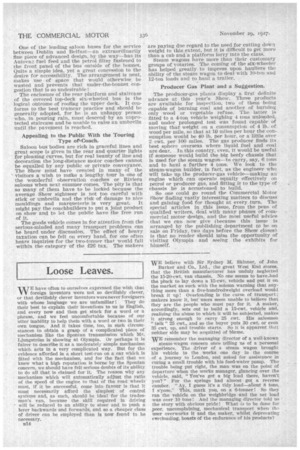Loose Leaves.
Page 40

Page 41

If you've noticed an error in this article please click here to report it so we can fix it.
WE have often to ourselves expressed the wish that foreign inventors were not so devilishly clever, or that devilishly clever inventors were never foreigners with whose language we are unfamiliar I They do their best to explain their inventions to us in English, and every now and then get stuck for a word or a phrase, and we feeluncomfortable because of our utter inability to help them with a word or two in their own tongue. And it takes time, too, in such circumstances to obtain a grasp of a complicated piece of mechanism like the Spontan transmission which Mr. Ljungstrom is showing at Olympia. Or perhaps it is fairer to describe it as a moderately simple mechanism which acts in a very complicated way. But for the evidence afforded in a short test-run on a car which is fitted with the mechanism, and for the fact that we knew what a high reputation is borne by the Spontan concern, we should have felt serious doubts of its ability to do all that is claimed for it. The reason why any mechanism which will automatically adjust the ratio of the speed of the engine to that of the road wheels must, if it be successful, come into favour is that it must necessarily afford the simplest of control systems and, as such, should be ideal for the tradesman's van, because the skill required in driving will be reduced to an ability to steer atld to push a lever backwards and forwards, and so a cheaper class of driver can be employed than is now found to be necessary.
n14 WE believe with Sir Sydney M. Skinner, of John Barker and Co., Ltd., the great West End stores, that the British manufacturer has unduly neglected the 15-20-cwt. van chassis. No one seems to have,had the pluck to lay down a 15-cwt. vehicle and put it on the market as :such with the solemn warning that anything more than a five-hundredweight overload would break it up ! Overloading is the curse of transport; makers know it, but users seem unable to believe that they are the people who must pay for it. A maker, accordingly, sets out to build a 15-cwt. vehicle and, realizing the abuse to which it will be subjected, makes it strong enough to carry 25 cwt. His salesmen "talk" 25 cwt., and so the buyer puts 30 cwt. or even 35 cwt. up, and trouble starts. So it is apparent that neither side may be acquitted of blame.
WE remember the managing director of a well-known
steam-wagon concern once telling us of a personal experience. The driver of a steam wagon brought his vehicle to the works one day in the course of a journey to London, and asked for assistance in curing a small trouble with his feed-water pump. The trouble being put right, the man was on the point of departure when the works manager, glancing over the vehicle, said, "You've got a big load there, haven't you'?" For the springs had almost got a reverse camber. "Ay, I guess it's a tidy load—afiont 8 tons, I s'pose." This, mark you, on a 6-tomer So they ran the vehicle on the weighbridge • and the net load was over 10 tons I And the managing director told us the story with obvious pride ! What is to be done for poor, uncomplaining, mechanical transport when ilv> user overworks it and the maker, whilst deprecating (Pverloading, boasts of the endurance of his products?
FOLLOWING upon the article in last week's issue of The Commercial Motor on "Progress with the Diesel Engine," we Were glad to have the opportunity of hearing a. lecture given by Dr. Rassbach at the works of J. A. Steven and Co., Ltd., on Wednesday last. Dr. Rassbach has been associated with the heavy fuel type of internal-combustion engine for some considerable time, during which he has experimented on an extensive scale with engines suitable for use in a commercial-vehicle chassis.
The main feature of the lecture consisted in an explanation of the functions of a special type of fuel injector and pump which is used in conjunction with the Arco patent design of combustion space. Briefly, the combustion space consists of (a) a cup let into the piston, (b) a venturi opening into the cup, and (c) a space between the cylinder head and the top of the piston. Fuel is injected into the piston cup via the venturi, where the air is highly compressed. Combustion follows almost immediately and continues for a large proportion of the power stroke, owing, of course, to the action of the compressed air from the piston cup passing back into the combustion chamber proper, giving a steady burning of the combustible gas, and so avoiding a sudden rise in pressure—an essential feature for a power unit intended for use on. the road.
DR. RASSBACH then went on to say that experi ments had been conducted with a four-cylindered engine running up to 2,000 r.p.m. and with a singlecylindered engine at speeds up to 2,700 r.p.m. without reaching the limiting speed of combustion. From an engine having four cylinders of 115 mm. bore and with a piston stroke of 180 mm., 50 b.h.p. had been obtained at 1,100 r.p.m., which enabled a heavily laden lorry to be propelled over a 450-mile route at an average speed of 181 m.p.h., which is no mean performance.
The whole subject of the Diesel engine—its progress and suitability for general road transport purposes— is one to which we attach the utmost importance. We hope in the near future to publish, a further authoritative article presenting the matter in an understandable but nevertheless technical form.




















































































































